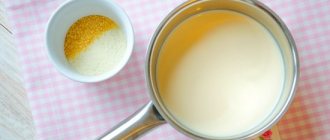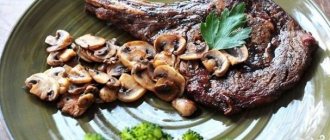Rosemary is a seasoning with a rich, noble aroma. Residents of Mediterranean countries: Italy, France and Greece love it very much. Rosemary not only adds a unique taste to food, but also has health benefits because it contains a large number of biologically active components. We will tell you which dishes this popular spice is added to.
What's good about rosemary seasoning?
Externally, rosemary resembles coniferous branches. When fresh, it has a strong aroma, intertwined with notes of pine, eucalyptus, camphor and lemon. The smell and taste of dried rosemary are revealed during heat treatment, as well as in combination with vegetable oil, cheese and other fatty foods.
The plant contains the following beneficial substances:
- Vitamins: A, B1, B2, B6, B9, C, PP. Thanks to them, rosemary (especially fresh) is beneficial for the skin, vision, and brain. It relieves muscle tension and stress, speeds up metabolism and helps you lose extra pounds.
- Macro- and microelements. The spice contains a lot of potassium and magnesium, which are good for the heart and blood vessels. 100 g of dried seasoning contains 128% of the daily requirement of calcium - the main macronutrient necessary for building bones. The plant also contains iron, zinc and selenium.
- Essential oils. Spices give antiviral, bactericidal, anti-inflammatory and tonic properties. They lift a person’s mood and relieve fatigue.
- Flavonoids. Protect the body from cancer, improve blood circulation and vascular tone.
Thus, rosemary definitely deserves a place in most people's diets. The spice can be added to almost any dish.
What is rosemary?
Rosemary is an evergreen perennial shrub of the Lamiaceae family, which also includes thyme, sage, thyme, mint, and oregano. The official name of the plant is ordinary or medicinal rosemary (Rosmarinus officinalis). The grass begins to bloom in April and matures by autumn.
Rosemary seasoning is actively used in European and Asian cuisines, as it harmoniously complements dishes made from a variety of ingredients, be it fish, meat, game or vegetables. The plant is also used to make essential oil, which is indispensable in cosmetology.
Rosemary also has medicinal properties, so it is used as a folk remedy for various diseases.
Where and how does it grow?
This plant prefers a warm, dry climate and does not tolerate excess moisture. Rosemary officinalis grows in the wild in the following countries:
- Türkiye;
- Libya;
- Algeria;
- Tunisia;
- Morocco;
- Italy;
- Portugal;
- Greece;
- Spain.
The plant prefers mountainous areas and well-lit areas. Wild rosemary does not grow in Russia. In cultivated form it is found in the southern part of the country.
Externally, rosemary looks like a subshrub with erect shoots. Its height can reach two meters, although standard plant species usually have a shoot length of 90 cm. The plant has powerful roots that go 3-4 meters into the soil.
Fresh needle-shaped rosemary leaves are gray-green on the top and silvery-white on the bottom. Dried leaves are gray-green. The flowers are blue in color.
Wild shrubs grow in one place for 10-15 years, and cultivated bushes, subject to proper care, for 20-30 years.
Types and varieties
The main types of rosemary are ordinary and prostrate. Unlike the first type, the prostrate one grows in width, forming a spherical bush. It is also called garden, as it is often planted for decorative purposes.
Varieties of common rosemary:
- "Tenderness";
- "Tuscan Blue";
- "Albiflorus";
- "Miss Jessopp's Variety".
Varieties of prostrate rosemary:
- "Creeping";
- "Corsican";
- "Venzano Prostrate";
- "Lavender".
The shrub is grown from seeds or vegetatively. Rosemary seeds can be planted immediately in the ground if they have been previously treated with growth stimulating agents.
Chemical composition and nutritional value
This spicy plant contains a number of mineral compounds. This:
- Potassium.
- Calcium.
- Zinc.
- Sodium.
- Magnesium.
- Copper.
- Iron.
Also, the chemical composition of this plant is represented by vitamins A, B3, B5, B6, B9, C and beneficial acids (oleic, myristic, lauric, caprylic).
100 g of fresh rosemary contains 131 kcal, 3.3 g protein, 5.9 g fat, 6.6 g carbohydrates.
Rosemary seasoning – how much to add to dishes?
The amount of rosemary in the finished food depends on the specific recipe. But usually 1 fresh sprig or 1 tablespoon of dried seasoning is enough for a dish that includes 4 servings.
You should not overdo it with the spice, as it has a strong taste. In addition, in excess quantities, rosemary increases appetite.
When to add rosemary to meat?
Rosemary is best suited for cooking meat dishes. It is better to add dried spice in the form of sprigs or powder to the meat at the beginning of cooking, so that the result is a richer aroma. The seasoning will give pork, beef and chicken flavor notes of game, and will also drown out the specific flavors of duck and lamb.
Fresh leaves, on the other hand, should be added at the end of cooking (1-2 minutes before serving) as they contain a lot of essential oils. If you put rosemary into meat right away, the dish will turn out bitter.
Beneficial features
Rosemary has been discovered, cultivated and classified as a medicinal plant. Endowed with many useful properties. It has antiseptic, anti-inflammatory and immunostimulating properties.
Rosemary has a positive effect on the nervous system, anxiety and stress. Normalizes sleep and relieves nervous excitability when prepared appropriately.
Promotes the removal of waste and toxins from the body, normalizes and supports the intestinal microflora as a whole and prevents the spread of various intestinal infections.
Hot compresses are prepared using rosemary for the treatment of the lumbar spine, cervical and spinal osteochondrosis, and knee joints. A water infusion of rosemary is used in the form of tea or chest mixture to treat diseases of the upper respiratory tract, lung diseases, and is prescribed as a gargle for colds.
Rosemary is also used as a pain reliever. Helps eliminate headaches, toothaches, post-operative pain syndrome and periodic female pain.
Scientists have proven that proper use of rosemary helps increase mental activity. Stimulates memory and normalizes all the most important processes of brain activity. As a result of taking rosemary, blood pressure rises for a short time, resulting in a tonic effect and relieving fatigue.
Where do you add fresh rosemary?
Fresh rosemary is often added to stewed vegetables, mushrooms, and soups. The aromatic leaves go especially well with green onions, zucchini, tomatoes, and potatoes. This plant is also used to flavor vegetable oils, cheese, and alcoholic beverages.
We recommend: The most delicious pie of this fall - prepare pumpkin manna on kefir with lemon and raisins
If you want to make delicious dishes with fresh rosemary, check out the recipes below.
Baked potato
A simple and very satisfying dish. To prepare it you will need the following ingredients:
- potatoes – 4–5 medium-sized pieces;
- fresh rosemary – 1 bunch;
- vegetable oil – 200 ml;
- salt.
Peel the potatoes and cut into even slices. Quickly fry them in vegetable oil until golden brown. Chop the rosemary. Sprinkle it over the slices. Salt the potatoes.
Place the slices on a baking sheet lined with foil or parchment paper. Place in the oven, preheated to 160 degrees, for half an hour. Serve potatoes at the table as an independent dish or a side dish for meat.
Baked zucchini
An excellent dinner option for those who adhere to the principles of proper nutrition, but do not want to go hungry in the evenings.
To prepare the dish, prepare the following products:
- zucchini – 3 pieces;
- fresh rosemary – 1 bunch;
- butter – 60 g;
- salt;
- ground black pepper.
Peel the zucchini, cut into pieces 1.5–2 cm long. Coat them with butter, salt and pepper. Chop the rosemary. Sprinkle it over the vegetables.
Place zucchini on prepared baking sheet. Place in the oven, preheated to 200 degrees, for half an hour.
Tomato soup with spices
This soup is good for people on a low-calorie diet, as well as vegetarians. It's very easy to prepare.
You will need the following ingredients:
- tomatoes – 1 kg;
- fresh rosemary - 1 sprig;
- vegetable broth – 1.5 liters;
- garlic – 2 cloves;
- vegetable oil – 1 tbsp. spoon;
- salt;
- dry paprika or adjika.
Cut each tomato into 4 pieces. Peel the garlic cloves and pass through a crusher. Place vegetables on prepared baking sheet. Bake in an oven preheated to 200 degrees for 40 minutes.
Cool the baked tomatoes and garlic, then transfer to the pan. Add chopped rosemary, vegetable oil, salt and spices to taste. Pour in vegetable broth and place on the stove. Bring the liquid to a boil and simmer the tomato soup for another 5 minutes. Before serving, you can add chopped fresh dill or green onions to the dish.
Flavored vegetable oil
Fresh rosemary can be used in cooking to flavor any oil, but it gives the most pleasant scent to olive oil. The technology includes the following stages:
- Pour 800–1000 ml of oil into a saucepan and heat over low heat to a temperature of 80 degrees.
- Mash two sprigs of spices thoroughly in your hands and place them in prepared glass containers.
- Pour the cooled oil into a container and seal tightly.
You need to infuse the oil for 2-3 weeks in a dark place at room temperature. Then it should be strained. The shelf life will be 6 months. Rosemary will not only give the oil a noble flavor, but also protect it from oxidation.
Where do you add dried rosemary?
Finding dried rosemary on sale is much easier than fresh leaves, so it is widely used in cooking. Add to meat and fish, marinades and sauces, and baked goods. The seasoning does not go well with bay leaf, but makes an ideal flavor ensemble with oregano, basil, thyme, marjoram, garlic and fresh parsley.
We recommend: Drying basil: 4 ways to prepare aromatic spices
Listed below are recipes to help you prepare delicious meals.
"Golden" chicken
The dish is well suited for a holiday table. It is unlikely to leave guests indifferent.
For cooking you will need the following products:
- broiler chicken – 1 pc.;
- lemon – 1 pc.;
- rosemary – 6 dried sprigs;
- garlic – 6 cloves;
- vegetable oil – 150 ml;
- butter – 50 g;
- salt;
- ground black pepper.
Mix chopped rosemary sprigs, crushed garlic cloves, lemon juice, vegetable oil, pepper and salt in one container. Rub the resulting marinade over the chicken. Place it on a baking sheet lined with parchment paper. Place in an oven preheated to 180 degrees for 45–50 minutes.
Remove the chicken and brush with butter. Place in the oven for another 15–20 minutes, during which time a golden crust will form on it. Let the dish sit for another 10-15 minutes before serving.
Fish baked in foil
Another dietary, but very tasty dish. To prepare it you should prepare the following ingredients:
- sea fish (for example, trout or mackerel) – 700 g;
- rosemary seasoning - 2 tbsp. spoons;
- lemon – 1 pc.;
- olive oil;
- salt;
- any spices for fish.
Cut the lemon and zest into thin slices and place on foil. Place cleaned fish on top. Coat it with olive oil, salt, season, sprinkle with rosemary. Wrap and place in the oven preheated to 180 degrees for 30–40 minutes. Serve with a salad of fresh vegetables.
Rosemary cupcakes
This unusual dessert will please true gourmets. If you want to prepare it, take the following ingredients:
- wheat flour - 1.25 cups;
- chicken eggs – 3 pcs.;
- sugar – 100 g;
- vegetable oil – 80 ml;
- low-fat cream – 60 ml;
- baking soda – 10 g;
- chocolate chips or raisins – 50 g;
- rosemary seasoning - 3 tbsp. spoons;
- salt - a pinch.
Using a mixer, beat eggs with sugar until fluffy foam forms. Add butter and cream. Stir and fluff lightly with a fork. Add flour, salt. Knead the dough. Add chocolate chips or raisins, rosemary, mix thoroughly again.
Grease muffin tins with vegetable oil. Place the dough in them and place in the oven, preheated to 180 degrees. In about 40-45 minutes, the rosemary cupcakes will be ready.
Thus, rosemary is a universal seasoning that suits most dishes. It emphasizes pleasant flavors and eliminates specific ones. Rosemary is also good for health, as it has a rich vitamin and mineral composition. Dried seasoning is sold in supermarkets all year round. But if you want to often add fresh spice to your food, you can grow the plant on the windowsill.
How to make rosemary infusion and oil
Rosemary has a coniferous, spicy smell and bitter taste, so it is used as a seasoning for various dishes. Thanks to its composition, the plant can have a healing effect on the body. It is a wonderful sedative, helps to relax and improve your mood. Rosemary also helps improve memory, slows down the aging process, and has an antiseptic effect.
For medicinal purposes, use rosemary in the form of oil or leaf infusion. To prepare the infusion, pour 1 tsp. dry leaves with two glasses of boiling water and leave for half an hour. Take the product 1-2 tbsp. 3 times a day. For infectious diseases and inflammation in the oral cavity, rinsing with rosemary infusion will be useful.
To make rosemary oil, place a few sprigs of the plant in a bottle and add olive oil. Place the bottle in a place well lit by the sun. After 6 weeks, strain the oil through a strainer or cheesecloth. Store it in a place protected from light.











